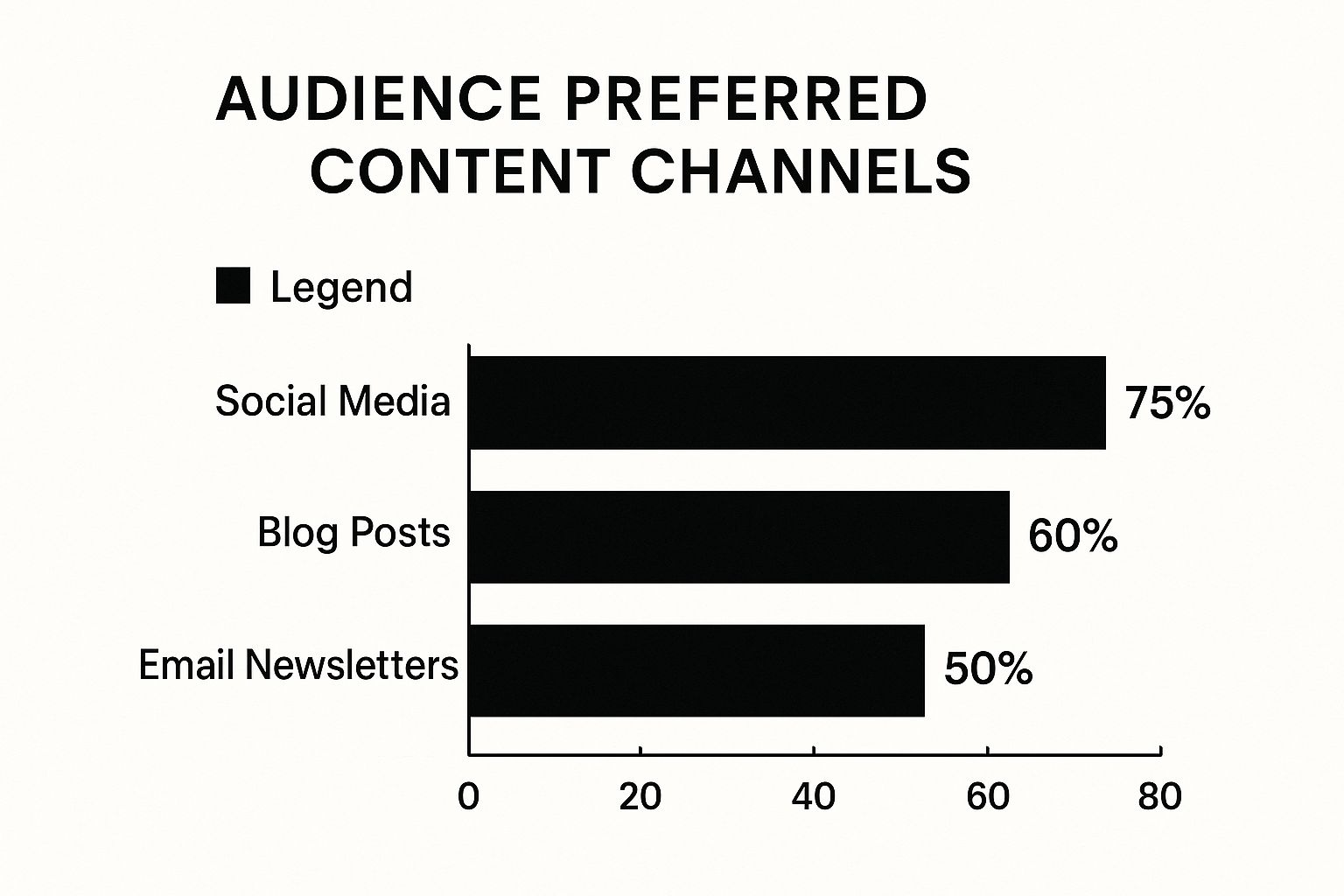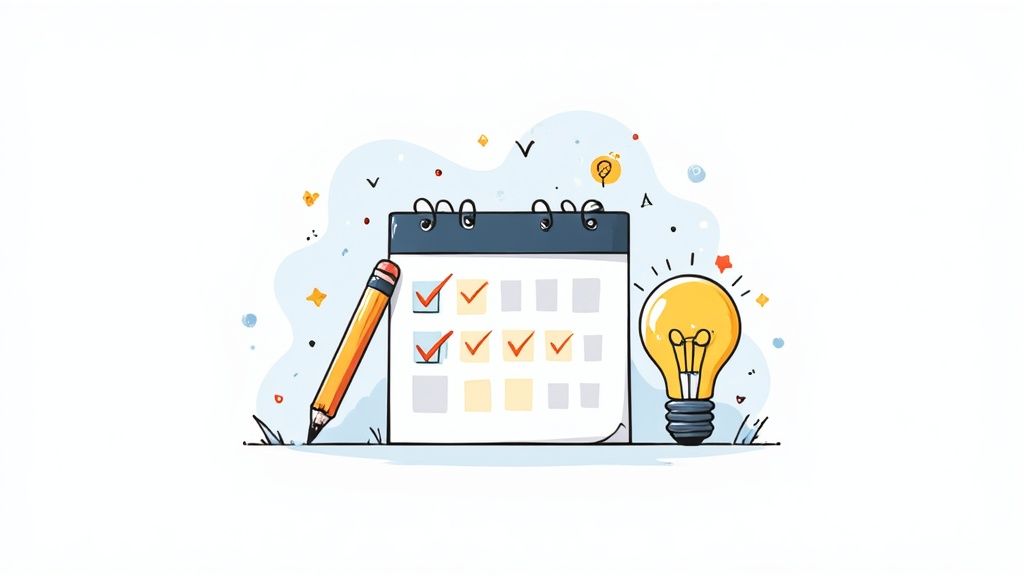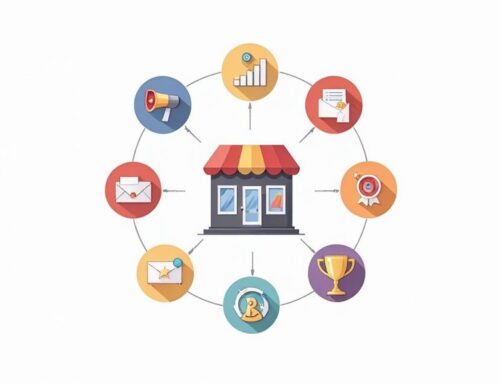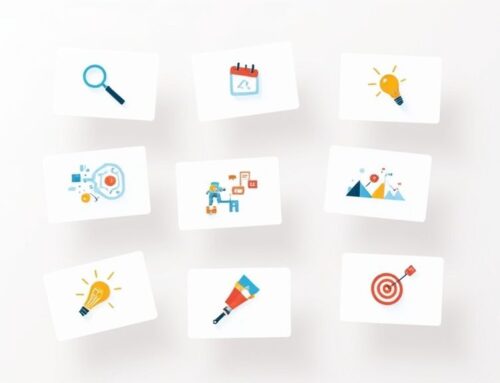When you run a small business, “content marketing” can sound like just another buzzword—something only big companies with huge budgets can afford to do. But really, it just means sharing what you know to attract the right kind of customers.
Think of it this way: instead of interrupting people with ads, you’re creating helpful, interesting stuff that draws them to you. It’s a slower burn, for sure, but it builds real trust and authority. The best part? It’s often much more cost-effective than traditional advertising and tends to bring in leads who are genuinely interested in what you do.
Building Your Content Foundation From Scratch
Getting started often feels like you’re just talking to an empty room. You’ve got a ton of knowledge about your field, but figuring out how to package it into a strategy that actually grows your business? That’s the tricky part. The goal isn’t to just churn out content; it’s about building a solid, purposeful framework from the get-go.
It all starts with your brand voice. You need to decide how you want to sound. A neighborhood coffee shop, for instance, might go for a warm, friendly, and community-driven tone. On the other hand, a B2B tech startup will likely sound more direct, professional, and data-focused. This voice is your signature—it’s what makes your content immediately feel like yours and helps you connect with the people you’re trying to reach.
Define Your Ideal Customer
Before you write a single word, you have to know who you’re writing for. And I mean really know them. Forget basic demographics like age and location for a minute. Your goal is to create a customer persona so detailed it feels like you’re describing a real person.
What problems are they trying to solve? What specific questions are they typing into Google at 11 PM? A freelance graphic designer’s target isn’t just “small businesses.” A much better target is “startup founders on a tight budget who need a professional-looking pitch deck but have zero design skills.”
When you understand their world on that level, you can create content that offers real solutions. You stop being just another vendor and become a trusted advisor. This customer-first mindset is the heart of any good digital marketing for small business strategy and is what turns one-time buyers into loyal fans.
Set Clear and Actionable Goals
Every single piece of content you create needs a job. If it doesn’t have a purpose, it’s just adding to the noise online. Your goals should be specific, measurable, and tied directly to a real business outcome.
So, what does that actually look like?
- Want more local brand awareness? Create a blog series where you interview other local business owners. Track website traffic from your city and see how many people in your community share it on social media.
- Need to generate 5 new leads a month? Offer a downloadable checklist (like “10 Things to Do Before Launching Your Website”) that people can get by providing their email. Your metric is simple: count the form submissions.
- Trying to become the go-to expert? Write a massive, in-depth “ultimate guide” on a complex topic in your industry—something more comprehensive than anything else out there. Then, track your organic search rankings for that topic and see if other sites start linking to it.
This goal-first approach stops content from being a random task and turns it into a strategic investment. It gives you a roadmap for what to create and a clear way to see if it’s actually working. The numbers don’t lie; a whopping 67% of small businesses are already using AI tools to get a leg up with their content marketing, helping them automate tasks and find valuable insights.
A documented strategy makes you proactive, not reactive. It transforms content from a random task on your to-do list into a reliable engine for growth, ensuring every blog post, video, or social media update serves a deliberate purpose.
Before you dive in, it helps to have a simple checklist to keep your initial efforts focused. This isn’t about doing everything at once, but about laying a strong groundwork for everything that comes next.
Your Initial Content Marketing Checklist
This table is a quick reference to help organize your foundational content marketing tasks and goals.
| Action Item | Key Objective | Example Tool/Method |
|---|---|---|
| Develop a Customer Persona | Deeply understand who you’re talking to. | Create a one-page doc using a HubSpot template. |
| Define Your Brand Voice | Ensure all content is consistent and recognizable. | Write down 3-5 adjectives (e.g., “Witty, helpful, direct”). |
| Set 1-2 Measurable Goals | Give your content a clear purpose from day one. | Use the SMART goal framework (Specific, Measurable, etc.). |
| Brainstorm Initial Topics | Map content ideas directly to customer pain points. | Use a simple spreadsheet or a tool like AnswerThePublic. |
Getting these core pieces in place first will save you a ton of headaches down the road. It ensures that when you do start creating, you’re not just guessing—you’re executing a plan designed to get real results.
Crafting Content That Actually Connects

Alright, you’ve figured out who you’re talking to and what you want to accomplish. Now for the fun part: creating the content. This is where a lot of small business owners hit a wall, thinking they have to churn out a massive volume of articles and posts just to keep up.
Let me be clear: quality and relevance will always beat quantity. Your goal isn’t to shout into the void. It’s to start a meaningful conversation with a real person who has a real problem you can solve. One of the best ways to do this? A good old-fashioned blog. For a small business, a blog isn’t a diary—it’s a powerful magnet for attracting your ideal customers.
Blogging is still one of the most effective tools in the content marketing shed. On average, businesses that keep a blog see 55% more website visitors. It makes sense when you think about it; nearly half of all buyers check out a company’s blog while they’re deciding what to purchase. If you’re curious, you can find additional content marketing statistics at DigitalSilk.com that really drive this point home.
Brainstorming Topics That Solve Problems
The best content ideas don’t come from a sterile boardroom meeting. They come directly from your customers’ most pressing questions. Your job is to listen—really listen—to what they’re struggling with and create content that hands them the solution on a silver platter.
A fantastic, and free, way to do this is right inside Google. Start typing a common question related to your industry into the search bar and keep an eye out for the “People Also Ask” box. This little feature is a goldmine of real-world questions your audience is actively searching for.
Let’s say you run a local landscaping company. A potential customer might search for “how to fix patchy grass.”
Google’s “People Also Ask” might spit out gems like these:
- What is the best way to fix a patchy lawn?
- How can I make my grass thicker and fuller?
- Why is my lawn so patchy and weedy?
- Can you just sprinkle grass seed on an existing lawn?
Boom. Each one of those is a perfect topic for a detailed blog post. By answering these questions thoroughly, you’re not just a service provider anymore; you’re the helpful expert they trust. This is the core of effective content marketing for small business—becoming the go-to resource.
Structuring Your Content For Readability
Got your topic? Great. Now you need to structure it so people actually read it. Let’s be honest, people don’t read online; they scan. A clean, simple outline is your best friend here, guiding readers to the information they need without overwhelming them.
I’ve found a simple, proven structure that works almost every time:
- An Engaging Introduction: Hook them immediately by addressing their pain point. Acknowledge their frustration and promise a solution right away.
- Clear, Actionable Steps: Break down your advice into logical, bite-sized sections. Use subheadings (like the ones on this page) to make the content easy to skim.
- Visual Aids: Nobody likes a wall of text. Use images, bullet points, or even a short video to illustrate your points and give the reader’s eyes a break.
- A Concluding Summary: Wrap it all up with the key takeaways and a clear call-to-action (CTA). Tell them what to do next, whether it’s “Contact us for a free lawn assessment” or “Download our lawn care checklist.”
This straightforward format helps you organize your thoughts and, more importantly, gives your reader a genuinely helpful experience.
The most powerful content doesn’t just inform; it connects on a human level. By weaving authentic stories into your content, you turn a simple blog post into a memorable experience that builds lasting trust with your audience.
The Power of Authentic Storytelling
Facts and figures establish your credibility, but it’s stories that build trust and make people care. As a small business, you have a massive advantage here because you’re overflowing with authentic stories. You can share your founder’s “aha!” moment, put a spotlight on a customer’s success story, or just explain the passion that drives your craft.
Imagine a small, artisanal coffee roaster. They could write a post detailing a recent trip to meet the farmers who grow their beans. Instead of just listing tasting notes like “hints of chocolate and citrus,” they can share photos of the farm, tell the story of the farmer’s family, and explain what makes that specific harvest so special.
Suddenly, it’s not just coffee anymore. It’s a product with a rich backstory. Customers are no longer just buying a bag of beans; they’re buying into a mission and connecting with the real people behind the brand. That emotional connection is something huge corporations spend millions trying to fake. Share your genuine stories, and you’ll create content that doesn’t just attract an audience—it builds a community.
Choosing the Right Channels for Maximum Impact
So, you’ve created some fantastic content. Now what? The next big hurdle is figuring out where to actually share it. With so many options out there, it’s easy to feel overwhelmed, especially when you’re a small business owner juggling a million other tasks.
Here’s the thing: you can’t be everywhere at once. And honestly, you shouldn’t even try.
The secret to smart content marketing for small business isn’t about blasting your message across every platform you can find. It’s about being strategic. You need to zero in on the channels where your ideal customers are already hanging out. The goal is to find the most direct path to your audience, not the one with the most detours.
Match Your Channel to Your Customer and Goals
First things first, pull out that customer persona you created. Where do these people spend their time online? If you’re a B2B software company selling to tech executives, your audience is on LinkedIn, not TikTok. On the flip side, if you’re a local bakery showing off custom wedding cakes, you’ll get way more mileage out of visual hubs like Instagram or Facebook.
Think of it like fishing. You wouldn’t cast your line in a puddle and expect to catch a marlin. You go where the fish are. Your content channels are the exact same—pick the ponds where your ideal customers are swimming.
Beyond your audience, you need to connect your channel choice to your business goals.
- Want to build brand awareness? Visually rich platforms like Instagram, Pinterest, or even TikTok are perfect for showing off your brand’s personality and products.
- Need to generate leads? A well-oiled blog, a targeted email marketing strategy, and LinkedIn are absolute powerhouses for capturing contact info from potential customers.
- Hoping to build a community? Facebook Groups or a dedicated Slack channel can create a genuine space for loyal customers to connect with you and each other.
This chart gives you a quick visual on where audiences typically prefer to find and engage with brand content.

As you can see, social media and blogs are still top dogs for discovery, but a solid email strategy is what turns those followers into a real, nurtured audience.
To make this even easier, here’s a quick reference guide to help you decide where to focus your efforts.
Content Channel Selection Guide for Small Businesses
| Channel | Best For | Audience Type | Effort Level |
|---|---|---|---|
| Blog | Establishing authority, SEO, lead generation | B2B & B2C, information seekers | Medium to High |
| Email Marketing | Nurturing leads, customer retention, sales | Existing customers & warm leads | Medium |
| B2B lead generation, professional networking | B2B professionals, industry experts | Medium | |
| Visual branding, e-commerce, community building | B2C, younger demographics (Millennials/Gen Z) | High | |
| Local businesses, community engagement, ads | B2C, broad demographics, local communities | Medium | |
| TikTok/Reels | Brand personality, viral potential, awareness | B2C, primarily Gen Z and younger Millennials | High |
| Driving traffic, product discovery, inspiration | B2C, predominantly female, creative/DIY focus | Medium |
Choosing the right platform is all about finding the sweet spot between your audience, your goals, and the kind of content you’re actually good at creating. Don’t feel pressured to jump on a new platform just because it’s trendy. Focus on what makes sense for your business.
A Closer Look at Key Channels
Let’s dig into a few of the most effective channels I see small businesses succeed with time and time again. Each one has its own quirks and requires a slightly different game plan.
The Power of Your Email List
If there’s one asset you should protect, it’s your email list. Seriously. It’s the most valuable marketing channel you have because, unlike your social media followers, you own your email list. You aren’t at the mercy of some mysterious algorithm change or the risk of a platform disappearing overnight. It’s a direct line to people who have asked to hear from you.
Here’s how to use it:
- Send out your latest blog posts to drive traffic right back to your website.
- Announce new products, services, or flash sales.
- Share exclusive content or tips to build loyalty and keep your brand top-of-mind.
For instance, a local boutique could send out a weekly style guide featuring new arrivals and a subscriber-only discount. It’s valuable content that also drives sales.
Never underestimate the power of a direct connection. Social media is fantastic for discovery, but email is where you build the lasting relationships that turn casual followers into paying customers.
Social Media: Where to Focus
Yes, you need to be on social media. But trying to master five different platforms is a surefire way to burn out. My advice? Pick one or two and go all-in.
- LinkedIn: This is the undisputed champion for B2B. It’s the perfect spot to share deep industry insights, compelling case studies, and professional thought leadership. It’s built for connecting with other business owners, potential partners, and high-value clients.
- Instagram: A visual paradise. It’s tailor-made for any business with a strong aesthetic—think restaurants, fashion brands, artists, or travel agencies. High-quality photos, engaging Reels, and behind-the-scenes Stories are your tools for success here.
- Facebook: It’s still a giant, particularly for connecting with local communities. If you have a physical location like a yoga studio or a coffee shop, Facebook is fantastic for promoting events, sharing customer reviews, and running highly targeted local ads.
Embrace Video and Thought Leadership
Video and in-depth articles aren’t just for big companies with huge marketing budgets anymore. These formats are absolutely essential for building trust and establishing yourself as an authority, and they’re more accessible than ever.
In fact, content marketing is leveling the playing field, allowing small businesses to compete with much larger corporations. The data backs this up: a recent analysis shows 61% of marketers plan to invest more in video this year, while 52% are upping their spend on thought leadership content. The trend is clear—it’s all about demonstrating expertise and engaging people on a deeper level. You can discover more marketing statistics from Data Axle USA that highlight this shift.
You don’t need a professional film crew. Your smartphone, some decent lighting, and a clear message are all you need to start. You can record short, helpful tips for Instagram Reels, film a “day in the life” of your business, or host a casual Q&A on Facebook Live. Authenticity will always win over perfect production quality.
Smart Content Promotion on a Small Budget

Writing a fantastic piece of content is a huge win, but it’s really only half the battle. If your ideal customers never see it, that brilliant article can’t do its job—it can’t bring people to your site, generate leads, or build your brand’s reputation. This is where smart promotion comes into play, and for a small business, it’s all about working smarter, not harder.
You don’t need a massive advertising budget to get your content seen. The secret is to squeeze every last drop of value out of each asset you create. Start thinking of each blog post not as a one-and-done item, but as a goldmine of raw material you can reshape and reuse across the web.
Squeeze More Value From Every Post
For a small business, the most efficient way to approach content marketing is to ditch the idea that you need to create something new from scratch every single day. Instead, take one solid, well-researched piece of content and chop it up into smaller, snackable assets for different platforms. This “create once, distribute many” model is a massive time-saver.
Let’s say you run a local landscaping company and just published a 1,500-word guide titled, “5 Common Landscaping Mistakes Local Homeowners Make.” Here’s how you could repurpose it:
- Social Media Graphics: Pull out the five key mistakes and design a simple, eye-catching carousel post for Instagram. Each slide can highlight one mistake with a clean graphic and a quick explanation.
- Email Newsletter: Grab the blog post’s intro to hook your email list. Then, bullet-point the five mistakes and link back to your website for the full breakdown and solutions. It’s a perfect way to drive traffic while giving your most engaged audience a valuable heads-up.
- Short Video Script: Turn each of the five mistakes into a quick 30-second video for TikTok or Instagram Reels. You can just film yourself on your phone explaining the problem and offering a fast tip to fix it. This stuff is super engaging and highly shareable.
- LinkedIn Article: Post a slightly trimmed-down version of the blog on LinkedIn. You could even reframe it for a B2B audience, like property managers or real estate agents in your city.
This one strategy ensures your core message reaches people where they already hang out online—all from a single piece of work. For a deeper dive into this, check out these powerful content promotion strategies that can seriously amplify your reach without draining your bank account.
Demystifying SEO for Your Business
Search Engine Optimization (SEO) sounds way more intimidating than it is. At its core, it’s just about making it dead simple for search engines like Google to understand what your content is about and who it’s for. As a small business owner, getting a handle on a few SEO basics can make a world of difference.
You don’t need to be an expert to see results. The two areas to focus on right away are keyword research and on-page optimization.
Think of SEO as giving Google a clear, well-organized map to your content. The better the map, the more likely Google is to send the right visitors directly to your doorstep.
Finding the Right Keywords
Keyword research is just a fancy term for figuring out the exact words and phrases your ideal customers are typing into Google. The goal is to find terms that are relevant to your business but aren’t so competitive that you’re up against massive corporations.
- Start with customer problems: What questions do you get asked all the time? If you’re a local plumber, this could be “how to fix a leaky faucet” or “why is my water heater making noise.” These are pure gold.
- Think locally: If you serve a specific geographic area, local keywords are your best friend. Instead of going after a broad term like “best pizza,” you’ll have much more success with “best pizza in Brooklyn.” It narrows the competition and attracts people who can actually buy from you.
- Use free tools: Google itself is a fantastic tool. Type in a search and look at the “People Also Ask” box and the “Related searches” at the bottom of the page. These are clues straight from Google about what people are looking for.
Optimizing Your Content on the Page
Once you have a keyword you want to target, on-page optimization is all about placing it in a few key spots within your content. This helps Google connect the dots and understand what your article is about.
Here’s a simple checklist to run through for every blog post:
- Put the keyword in your title: Make it sound natural. Something like, “How to Fix a Leaky Faucet in 5 Easy Steps.”
- Use it in your introduction: Mention your main keyword somewhere in the first paragraph or two.
- Sprinkle it in your subheadings: Break up your content with H2 and H3 tags that include your keyword or a close variation.
- Optimize your images: Don’t upload images with names like
IMG_1234.jpg. Rename the file to something descriptive (e.g., leaky-faucet-repair.jpg) and use your keyword in the “alt text.”
By mastering content repurposing and these SEO basics, you can dramatically increase the return on your content efforts. It ensures every single hour you put in works as hard for your business as you do.
Measuring What Matters Without Getting Lost in the Data

So, you’ve put in the work to create some great content and get it out there. Now comes the part that can feel a bit daunting for many small business owners: the numbers. It’s incredibly easy to get swamped by endless charts and graphs, but trust me, measuring your content’s performance doesn’t have to be a headache.
The real secret is to tune out the noise. We need to focus on just a handful of metrics that actually tell you if your content is helping your business grow. Chasing metrics like “likes” or raw “page views” can feel good, but they’re often what we call vanity metrics. They look impressive on the surface but don’t always connect to real results.
Instead, let’s focus on the numbers that truly matter. The goal here is to create a simple, clear picture of what’s working so you can double down on it, and what isn’t, so you can fix it.
Setting Up Your Measurement Toolkit
You don’t need to shell out for expensive, complicated software to get started. Honestly, two free tools from Google are more than enough for most small businesses to track the key performance indicators (KPIs) that link content to actual growth.
- Google Analytics (GA4): Think of this as your website’s command center. It shows you who’s visiting your site, how they found you, and what they do once they’re there.
- Google Search Console (GSC): This tool is all about your performance on Google Search. It reveals which search terms are bringing people to your site and helps you spot technical glitches that could be holding you back.
Getting these set up is pretty straightforward, and the insights you’ll gain are priceless for any content marketing for small business strategy. They give you the hard data you need to make smart decisions instead of just guessing what your audience wants.
Key Metrics That Actually Drive Business Growth
Let’s cut through the clutter and get right to the data points you should be watching. These metrics tell a story, from how you’re attracting initial interest all the way to how you’re driving sales.
- Organic Traffic: This is the number of people who find your website through a search engine like Google, not from paid ads. If you see this number steadily climbing, it’s a fantastic sign that your content and SEO efforts are paying off. You can track this right in Google Analytics.
- Conversion Rate: This might be the most important metric of all. A conversion is any specific action you want a visitor to take—filling out a contact form, signing up for your newsletter, or buying a product. Your conversion rate is the percentage of visitors who take that action, telling you how persuasive your content truly is.
- User Engagement: Are people actually sticking around? Look at metrics like Average engagement time in GA4. A longer time suggests people find your content genuinely valuable and are actually reading or watching it, not just clicking away.
Chasing page views without context is like counting how many people walk past your storefront. Your conversion rate tells you how many people actually walked in the door and bought something. Focus on the metrics that reflect real business impact.
Tracking these KPIs helps you understand the true effectiveness of your work. If you want to dive deeper into the financial side of things, learning about the ROI of content marketing is a great next step to connect your efforts directly to revenue.
Creating a Simple Performance Dashboard
To keep yourself from drowning in data, create a simple dashboard to track your most important numbers each month. You can do this in a basic Google Sheet. It doesn’t need to be fancy; it just needs to be consistent.
Here’s a simple template you can copy:
| Metric | Last Month | This Month | Change | Notes |
|---|---|---|---|---|
| Organic Traffic | 500 visitors | 650 visitors | +30% | Our “how to” blog post took off! |
| Newsletter Signups | 15 | 25 | +67% | The new checklist download was a hit. |
| Contact Form Fills | 5 | 8 | +60% | Added a clearer call-to-action on the services page. |
| Avg. Engagement Time | 1m 15s | 1m 45s | +40% | Seems like longer, more detailed content is resonating. |
This simple monthly check-in keeps you laser-focused on what moves the needle. It helps you spot trends, celebrate your wins, and pinpoint areas that need a little more love. Over time, this dashboard becomes a powerful record of your content marketing journey, guiding your strategy with real data, not just assumptions.
Common Content Marketing Questions Answered
Even with the best-laid plans, you’re going to have questions. It’s just part of the process. Let’s dig into a few of the most common hurdles I see small business owners face when they first get serious about content marketing.
How Much Should a Small Business Spend on Content Marketing?
There isn’t a one-size-fits-all answer here, but a solid benchmark is to set aside 7-10% of your total annual revenue for all your marketing efforts. When you’re just starting with content, though, your biggest investment is usually your time, not your money.
Forget about a massive budget for now. Instead, focus on creating a consistent rhythm. Can you commit to one really good blog post a week and the social media effort to share it? Start there. Once you see what’s resonating with your audience, you can wisely invest money to scale up.
As you grow, you might consider putting money toward:
- Bringing on a freelance writer to help you publish more often.
- Upgrading to a tool like Canva Pro to create better-looking graphics.
- Putting a small ad budget behind your best-performing articles to get them in front of more people.
The trick is to start small, track what’s actually working, and then double down on the activities that give you the best return for your time and money.
What Is More Important for SEO: Quality or Quantity?
Quality. Every single time. And this is non-negotiable for a small business trying to punch above its weight.
Google’s whole game is to find and reward content that is thorough, trustworthy, and genuinely helps the searcher. Think about it: one comprehensive, 1,500-word guide that perfectly solves a customer’s problem will always beat ten shallow, 300-word posts that barely scratch the surface.
Your goal shouldn’t be to just write an article; it should be to create the single best, most helpful resource on the internet for that specific topic. When you adopt that mindset, you build incredible trust with both your audience and search engines, which pays off for years to come.
This focus on quality is the bedrock of smart content marketing for small business. It helps you build a library of evergreen assets that keep working for you long after you hit publish.
Can I Do Content Marketing Myself, or Do I Need to Hire Someone?
You can absolutely do this yourself, especially in the beginning. In fact, you’re probably the most qualified person for the job. No one understands your customers and their pain points better than you do. That’s your secret weapon.
Start by carving out a few dedicated hours each week. Block it on your calendar like any other important meeting. Use that time to write a blog post or create content for your social channels. You’d be surprised what you can accomplish with a little focus and the right tools.
Here’s a simple toolkit to get you started:
- Content Creation: Your brain! Write what you know.
- Design: A free tool like Canva is perfect for making professional-looking images.
- Analytics: Google Analytics and Google Search Console are free and essential for tracking your progress.
Down the road, as your business grows and your time gets stretched thin, you can start outsourcing. Maybe you hire a freelancer to write blog posts or a virtual assistant to schedule your social media. But by starting the work yourself, you build a solid foundation and ensure your brand’s voice stays authentic.
Ready to build a content strategy that drives real growth without the guesswork? The team at ReachLabs.ai specializes in creating data-driven marketing solutions that elevate your brand’s voice and deliver measurable results. Let us help you turn your expertise into your most powerful marketing asset. Discover how we can help you.





